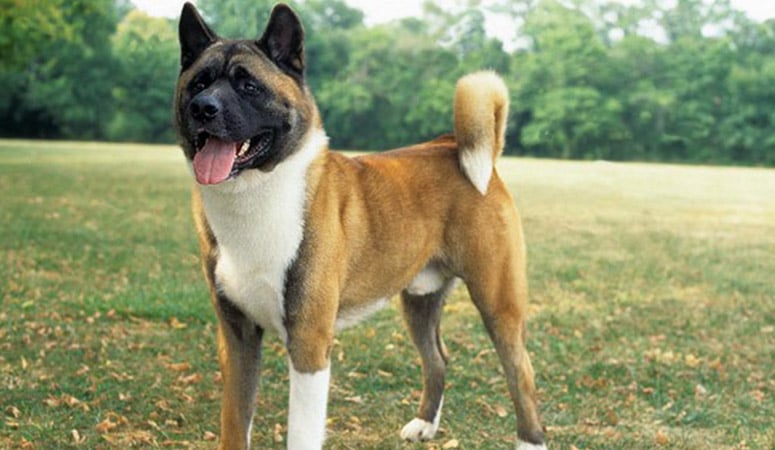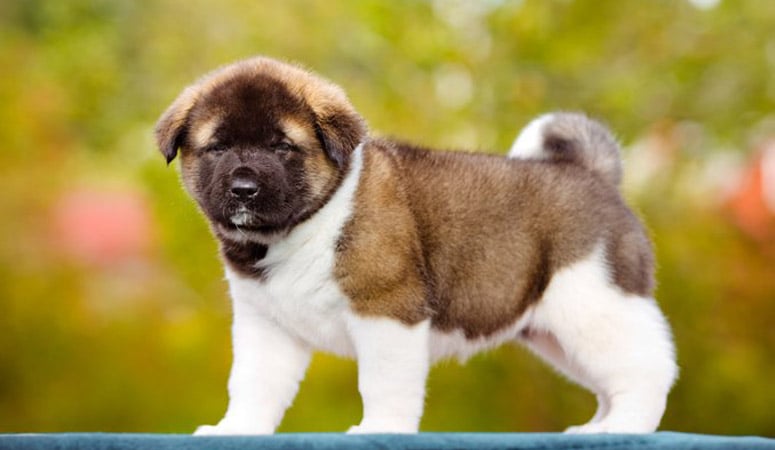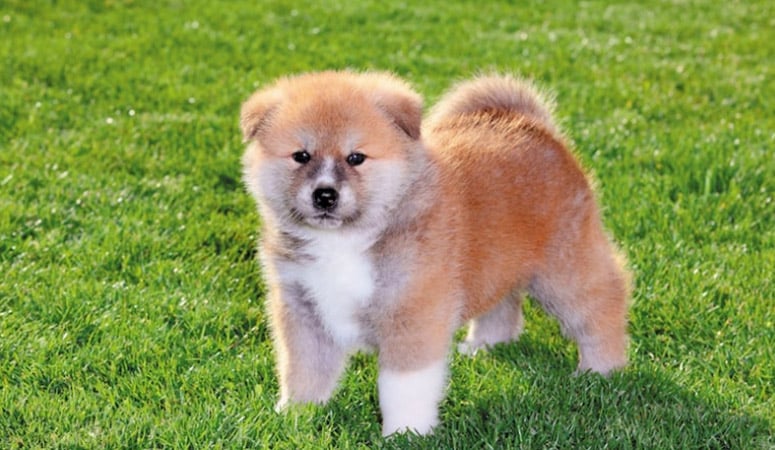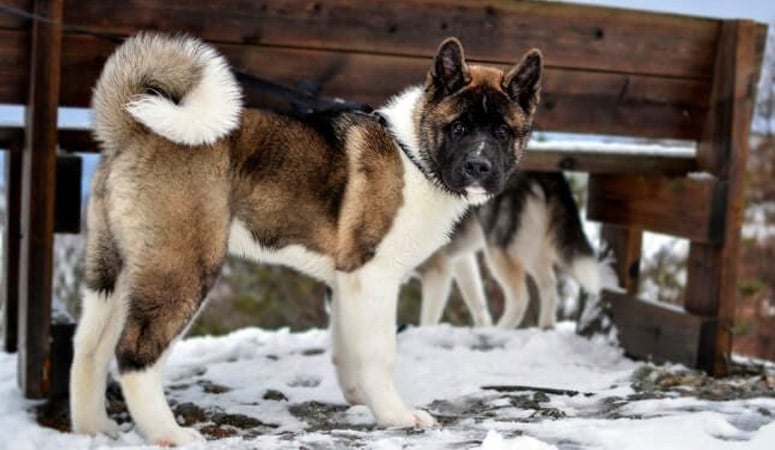Akita
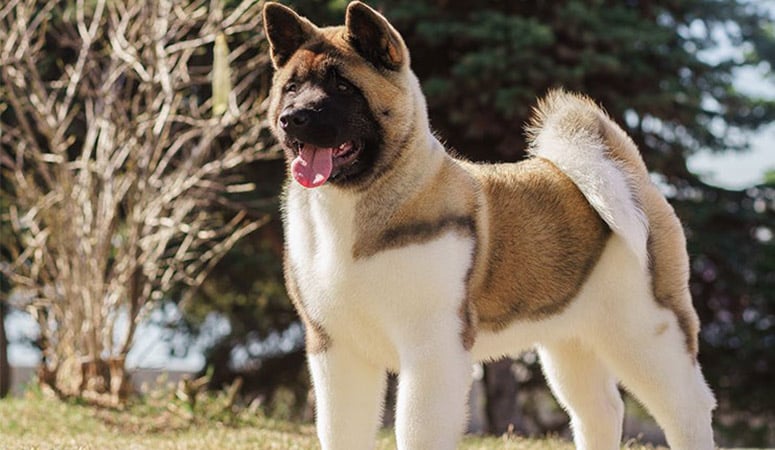
Large, alert, and wise, the Akita is a powerful dog breed with a noble and intimidating presence. Originally from Japan, they were used for guarding royalty and nobility. Akita is kind, playful, and loving with their families, but they are restrained to the strangers. Although eager to please, they have a strong and independent streak and fixed boundaries.
| Other Names | Akita Americain, Akita Americano, American Akita, Amerikanischer Akita |
| Color | Black, Brown, Red, White |
| Height | Males: 26-28 inches. Females: 24-26 inches. |
| Weight | Males: 100-130 pounds. Females: 70-100 pounds. |
| Life Span | 10-13 years |
| Personality | Courageous, Dignified, Profoundly Loyal |
| Exercise | Energetic |
| Origin |
| Popularity | #47 |
| Groom Needs | Daily |
| Kids Friendly | Yes with supervision |
| Dog Friendly | No |
| Watch Dog | Yes |
| Family Dog | |
| Litter Size | 7-8 |
Akita Pictures
Akita Video
Introduction
The original Japanese Akita has a short double coat, that is present in red, brindle, ginger or white color varieties, with white markings anteriorly. This is unlike the American Akita which often has a mask and pinto covering. The Akita is a tough and powerful breed, with a commendable meticulous twist to the execution of duties. Fond of standing aloof to strangers, yet they are surprisingly friendly companions to their family members.
A standard male weighs approximately 105-125 pounds and stands to a height of 26-28 inches from paw to shoulder. A similar female is equally prominent in proportions, weighing close to 90 pounds, at a shoulder height of 23-26 inches. The Akita is a loyal protector of home and family, often out-doing themselves for loved ones.
This breed has risen out of the clutches of extinction to become a well-recognized dog breed in different countries of the world. On average, Akitas live to the age of 12 or 13 before they eventually die.
Living with Akita
Akitas tend to be clean and have little “doggy odor.” They don’t need extra grooming, but they are significant shedders and need daily brushing when ‘blowing’ their dense undercoat, and every few days the rest of the year. Regular brushing can help Akitas remove the dead hair and help reduce the amount of hair in your house. In spite of their self-grooming habits, the Akita also needs bathing every three months or as needed.
Check their ears once a week for dirt, redness, or a bad odor that can indicate an infection, and wipe the ears out by using a mild cleanser to prevent problems. Remember to brush the dog’s teeth often to ensure dental health. And trim their nails regularly because overly long nails can cause pain and problem for the dog.
Although Akitas are not a super hyper high energy breed they are still fairly active and energetic. This is a smart, strong breed that will appreciate mental and physical exertion every day. Actually, daily exercise could help keep Akitas to be well-mannered, exercise at least an hour every day can maintain good health and condition. Akitas also enjoy playing energetically, games and tricks can provide needed mental exercise.
With sufficient daily exercise, Akitas can do well in a relatively small home although they are large dogs
Akita dogs are prone to bloating or gastric torsion, so feeding a large meal every day is not a good idea. It is better to divide the amount you feed your dog into two meals, and feed them once in the morning and again at night.
The amount of food for Akitas should depend on their weight and activity levels, and some dogs are easy to get overweight, so you need to watch their calorie consumption and weight level all the time. There should be clean fresh water at all times. It is recommended that Akitas aged 7 years and older should be fed a less calorie-dense diet to prevent kidney disease.
Treats may be an important aid in training, but excessive intake can lead to obesity. Also, owners need to distinguish which human food is safe for dogs and which are not. If you have any problems with your dog’s weight or diet, just consult from your veterinarian.
Akitas may be prone to the following conditions: thyroid disorders, hip dysplasia, malformation of the hip joints that can cause pain and arthritis…
Major concerns: CHD, PRA
Minor concerns: sebaceous adenitis, pemphigus, gastric torsion, elbow dysplasia, cruciate ligament rupture, lymphosarcoma, osteosarcoma, hypothyroidism
Occasionally seen: PRA, entropion, patellar luxation, cataract, VKH-like syndrome, epilepsy, polyneuropathy, microphthalmia, renal cortical hypoplasia
Suggested tests:
Hip Evaluation
Thyroid Evaluation
Ophthalmologist Evaluation
Total Annual Cost: $3562
Cost is estimated for the first year and may vary depending on many factors, such as dog food, health care, leash, collar, licensing, possible fencing, crates, training and obedience classes, dog-walking, grooming, treats, toys, flea, tick, and heart-worm meds, microchips, etc.
Akita people are very smart and loyal, but they also have an independent and tough nature. As a large and very powerful dog, it must be continuously trained from an early age. The Akita needs a strong owner since it has a strong will and tends to be stubborn.
Akitas are good at advanced obedience and dog sports courses, although the experience must be kept fun and varied to maintain their interest. Akita dogs like personal attention very much, so they are very suitable for service and therapy dog training.
Akitas perform best in daily work, so it learns what is expected. As a puppy, start with basic commands and gradually learn more complex lessons as your dog approaches the age of four to six months.
Akitas tend to attack other dogs, especially same-sex dogs, and you should be careful when interacting with dogs.
History
The Akita dog breed is a native of Japan. It has a complicated history that dates back to 7th century Japan. Their ancestors, the Matagi Inu dogs, were hunting dogs, used for poaching wild boar, local deer, bear, and some other wild sports. They were popular amongst the Matagi tribe of Japan. Myth has it that the Matagi Inu dogs were probably developed from Spitz-type dogs brought into northern Japan from eastern Europe when the country was not yet an island.
In Japan, upheavals tend to disrupt the steady growth of native dog breeds. There were times when a drastic decline would occur and also times when conscious efforts were made to cause the flourish of the existing breeds. The Matagi Inu, ancestors of the modern-day Akita weren’t left out of the undulating experience. However, things later improved with the turn of the 20th century.
In the early part of the 20th century, dogfighting became a popular sport in Japan and some parts of Europe. Breeders saw a need to develop a larger breed that could compete at the fights, hence Matagi Inu dogs were crossed to large size mastiff dogs of both Europe and Asia. This gave rise to a variety of this breed that was a bit divergent with the original breed.
It was in 1931 that the name ‘Akita’ was used to identify the native original Matagi Inu breed. Other varieties related to this breed were also recognized in Japan, shortly after which a standard for the breeding of the Akita was drafted in 1934. After World War II, the population of these dogs was depleted almost to extinction due to mass killing for their fur to be used for military purposes. Years later, breed fanciers and other organizations successfully resuscitated the lineage of this breed to what we know today. The Akita was recognized by the American Kennel Club in 1955.
Helpful Information
Breed Club: AKITA CLUB OF AMERICA
Breed Club Link: http://akitaclub.org/
Breed Club Rescue: The Akita Club of America Rescue
Breed Club Rescue Link: www.akitaclubrescue.org

